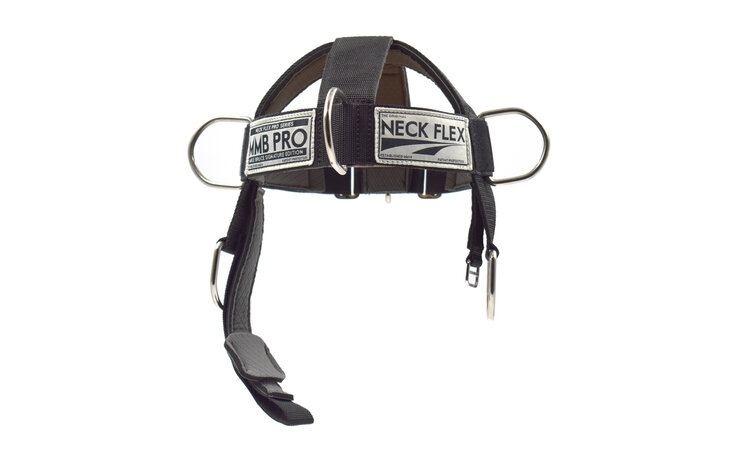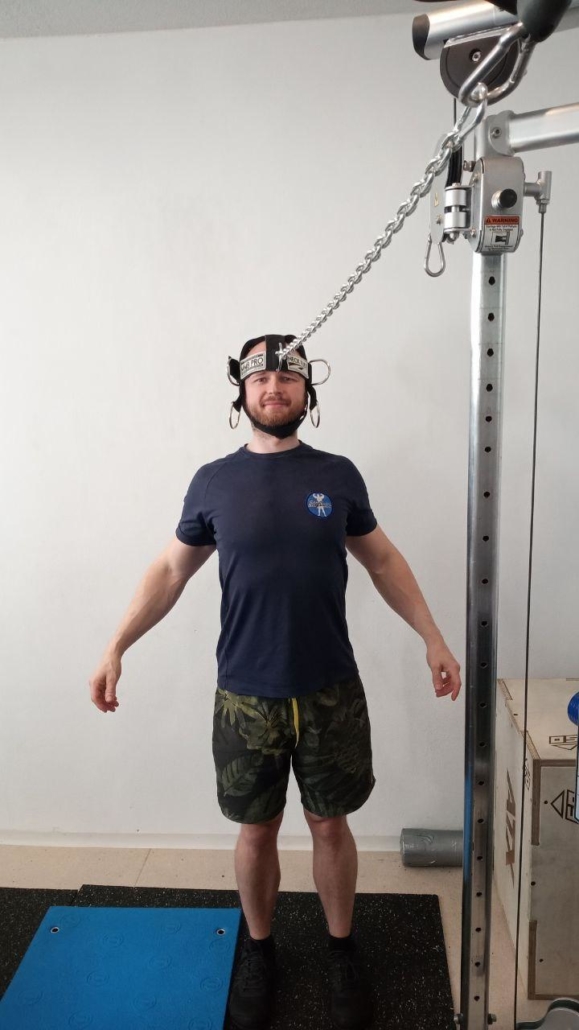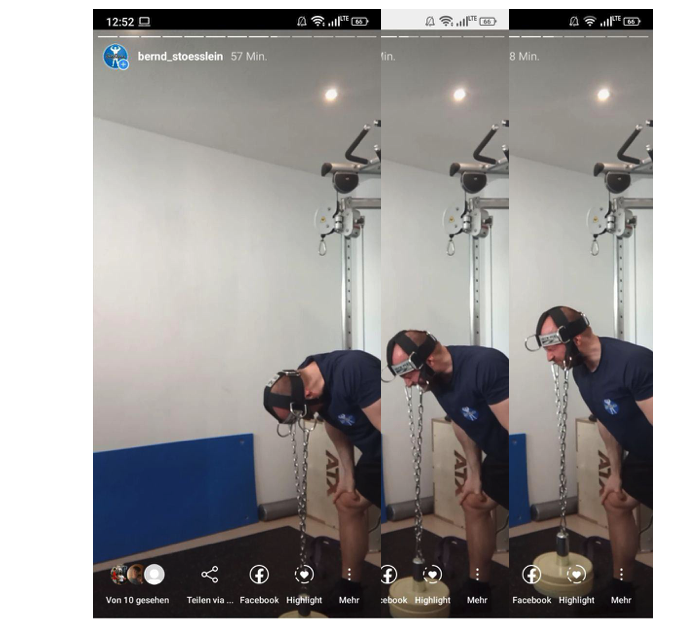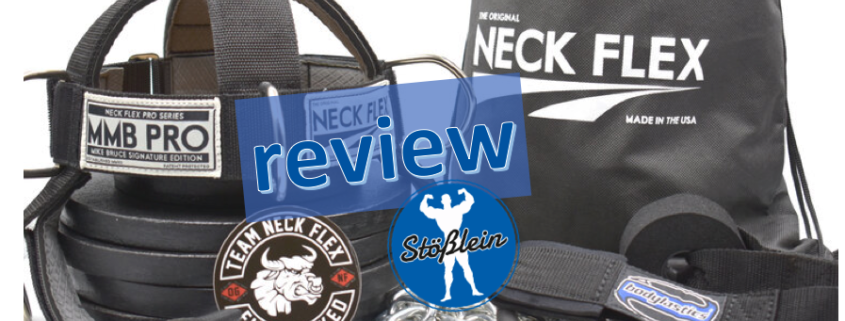Neck Flex – Due to my observation, expertise neck training, besides grip training, is one of the most neglected and underrated parts of strength training. In amateur as well as in professional sports! Just keep in mind, that only because someone pretends to be, or even is, a professional athlete (which is even worse and also embarrassing for his or her trainer) they are not necessarily doing professional workouts! Prepare for some serious neck attacks in this article! I’ll show you how you can proceed from a pencil neck to getting “yoked” with a cool neck training tool, the Neck Flex Pro, and the according techniques.
Let’s get yoked…
Neck Flex – The Story behind the tool
I communicated with the very friendly staff from Neck Flex as I wanted to know more about what drove them to create their stunning neck training tool. They said:
„The co-founders of the Neck Flex both had varying backgrounds in fitness when coming together with the ideals which supported the need for a new and innovative approach to neck training and development.”
They further stated that:
“There was an obvious need for attention to be drawn towards athletes and the importance of neck strength in order to ideally prevent neck and head injuries. The more research that was conducted, the more it became apparent how vital neck strength truly was in preventing these common neck and head injuries that often occur within the field of contact sports and also within the military.”
Moreover they told me:
“As all this research came flooding in, it was then and there that it was decided to create the most effective and versatile neck training device. Everybody is mostly familiar with the standard methods of neck training, such as plate loading with chained head harnesses, machine based neck stations, bridging, and also isometrics.”
In addition to that they wrote:
“So based off the those standard methods, a design was orchestrated that could not only provide a limitless range of motion and resistance, but also provide a very high level of safety in which virtually any gender, age, or background could easily use the product.“
According to that they continued with:
“After a couple years of testing and development the Neck Flex was finally ready for action. Every step was taken to ensure that the Neck Flex was of the highest quality and a step above all others that have come before.”
Concluding they added:
“The ultimate goal of Neck Flex is to promote and provide the means in which to effectively and efficiently train the neck for everyone from contact sports, military members, youth sports, fitness enthusiasts, and also to those just looking to simply firm or tone their necks. Whatever your training goal is… Neck Flex has got you covered.” (Neck Flex, 2020)

Neck Training – Last but (not) least?
As you know the saying normally goes: “last, but NOT least”. Unfortunately when it comes to the training of the neck it is probably the opposite!
Of course some bodybuilders build their traps (as traps are supposed to be the “new” abs) but most often only emphasize the upper part of the m. trapezius, which is only ONE of many muscles that enable the movement of your neck!
Moreover, from a sport-specific training point of view, lots of athletes suffer from something that Charles R. Poliquin, aka “Strength Sensei” (R.I.P.) used to call structural balance deficiencies.
According to that it is not uncommon for athletes suffering from faulty movements and/or bad posture.
What your brain has to do with your movements, how your eyes, respectively your sight influence your posture etc. can be found in depth in my article:
POSTUREPRO BRAIN COACH PERFORMANCE CERTIFICATION REVIEW
There are literally thousands of tests to perform/asses restricted movements and or postural deficiencies/disbalances and exercises to correct them. But, how many (ever professional) athletes have you seen performing proper neck training?
It is hardly done and sadly overlooked too often! Why? To be honest I don’t
know! Neck training and grip training are probably the two most overlooked
things, when it comes to (professional) strength and conditioning training.
More about how to become a certified strength and conditioning coach can be found in my article:
NCSF CERTIFIED STRENGTH COACH REVIEW
Back to the neck: When you are training in a sport specific manner it differs way from what people like to call “fitness” training. Fitness training is more about burning (as much as possible) calories, i.e. in order to lose excessive body fat.
Sport specific strength on the contrary focuses on sparing calories while improving an athlete’s economy, depending on the sport he/she wants to perform (team sport vs. individual sport).
Depending on that, it makes sense that you must train an athlete not only to be strong or to be “in good shape” (lean, and muscular) but in a manner that he/she is able to perform at his/her best during a competition.
That is important as it emphasizes that neck training, in the first place, is not meant to be an aesthetical integration into e.g. a bodybuilding routine.
Remember, as Louie Simmons from Westside Barbell quoted: “big ain’t strong. Strong is strong”. Furthermore, being muscular does not necessarily mean that someone is strong, too!.
But what actually is strength? Well, as this is not the main topic of this article I’ll only give you a very short explanation:
Physical strength is determined by the cross-sectional area of muscle fibers as well as the intensity of so called “motor-unit” recruitment (quality and quantity).
In a nutshell, strength does not equal power, power is not the same as work and/or force and so on.
As you can see, strength and conditioning training is far more complicated than simple “pumping up” in the gym.
You must assess and correct an athlete’s weakness, and create a proper structural balance.
That’s where neck training comes into consideration, as a “pencil neck” won’t be able to enhance an athlete’s performance through increased strength nor enable improved shock absorption capacities in sports with lots of collisions, like American Football or Rugby.

Neck issues and its correlation to chronic fatigue syndrome?
Besides being a Strength and Conditioning Coach/Personal-Trainer & Consulting Biohacker I’m also working in Germany as a “Heilpraktiker”, too.
A proper translation would be something like “complementary and alternative medicine practitioner”. I’m allowed to diagnose and treat disease (with restrictions) and i.e. use invasive techniques, e.g. injections and/or i.v. infusions.
I see lots of patients in my practice who are complaining/suffering from chronic fatigue syndrome, aka “secondary mitochondropathy”. Now I can hear you asking: “What might have mitochondria and a syndrome to do with the training of the neck?”
Well according to Dr.Dr. Kuklinski (affiliate link) an instability of your neck can cause a wide range of (severe) symptoms you normally would not automatically associate with your neck!
Accidents (trauma) and overstretching can damage ligament structures in the neck joint which might lead to a permanent hypermobility in the neck!
Depending on the head’s postures, this hypermobility might lead to circulatory disorders in the brain, e.g. dizziness, rapid heartbeat or visual field deficits.
Often this isn’t noticed at all or, as mentioned before, not associated with “issue in the tissue” of your neck.
In addition to that, these circulatory disorders may also occur during sleep, depending on your head resting position.
The brain cells then will start to “panic”, in fear of suffocating, due to lack of oxygen. In response to the circulatory disorder, they release large amounts of nitric oxide (NO).
Dr. Dr. Kuklinski calls this: “nitrosative stress”. The excessive release of NO might lead to the destruction of intracellular vitamins and might excrete micronutrients through the urogenital tract.
This is such an interesting topic, but it is not the main part of this article! I just, again, wanted to show you how many facets the training of your neck “kaleidoscope” has ! And most of them are overlooked.
Like all of my blogposts this one is intended to give you some impulses and to be used as a springboard to your own research!
The only thing I can do is aid you how to help yourself.
Neck Flex – How to attack your neck?
Like in most of my articles about training devices, I like to make a short but necessary excursion into functional anatomy. Just to give you an overview of how the Neck Flex can be usefully integrated in a structured training program
So, let’s have a look at the neck!
Most important muscles of your neck:
- M. rectus capitis posterior minor (tilt the head to the same side & dorsal extension)
- M. obliquus capitis superior (ipsilateral head tilting & double sided dorsal extension)
- M. rectus capitis posterior major (ipsilateral turning of head & double sided dorsal extension)
- M. obliquus capitis inferior (ipsilateral turning of head & double sided dorsal extension)
- M. sternocleidomastoideus caput mediale & laterale (unilateral contraction, tilting the head to the same side, turning the head to opposite side, dorsal extension)
- M. trapezius (pars descendens)
As you can see, the neck is quite a “tricky part”. The above mentioned list is, by all means, not complete and there are much more deep-lying muscles that should be considered!
Neck Flex – How I use it
Neck flex manufactures two different types of neck-training devices. The “original” Neck Flex and the “Neck Flex Pro”. This review focuses on the latter.

The USA-based company itself describes their product as followed:
“The Neck Flex MMB Pro Series is truly game changing in all aspects of design. It was developed with the unwaivering intention of producing a harness and kit which surpasses all others in terms of versatility, function, and construction. The MMB Pro Series was designed in close collaboration with Mike Bruce, and thus it proudly bears his initials out of our tremendous respect for all he has accomplished and contributed towards the pursuit of neck strength and conditioning. The MMB Pro series takes our patented Neck Flex platform and introduces”dog ear” anchor points, which allows for the integration of plate loading applications as well as resistance band applications. No other head harness in the world can lay claim to such a design. However the ground breaking design is just one feature of the MMB Pro Series. Our construction materials and methods also adhere to the highest standards of quality. This includes diamond embossed neoprene padding, heavy duty nylon webbing, and all buckles are composed of polished metal. We set forth to raise the bar, and after much time and effort we are proud to present the MMB Pro Series.” (Neck Flex, 2020).
For the Neck Flex Pro the company charges around 110$ which, from my perspective, is a really fair price! Besides the neck harness you’ll get:
- Heavy Duty Chain for plate loading
- Carabiners for chain attachments
- Bodylastics Patented 19 lb (=8,6kg) Resistance Band
- Bodylastics Door Anchor
- Neck Flex Tote Bag
Of course the other, priceless, advantage of the Neck Flex is its portability. You can store everything in your gym bag and take it with you when hitting the road and train, in different gyms or even a hotel room! A very versatile approach!

Neck Flex/Neck Training Conclusion
As Strength and Conditioning Coach I highly recommend professional athletes to incorporate neck training into their strength training. Of course there are myriads of possibilities how you can train your neck.
With machines, other devices or even only your bodyweight. Incorporating a Neck Flex though might be the most bang for your buck-approach if you don’t have a lot of space/budget for machines or other fancy equipment to get “yoked”.
Integrating neck training into your workout routine might be the “missing link” you’ve been looking for to break plateaus and/or boost your performance. No matter if you’re just a “weekend-warrior” or a professional athlete!
© HP Bernd Stößlein, Master of Business Administration in Sportmanagement.
If you liked this article please share it with your friends, subscribe to the newsletter and the blog.
If you like to book a professional online/offline consultation please feel free to contact me:
Literature
Neck Flex, About us, source: https://www.theneckflex.com/about-us-1, access from 10.09.2020.
Neck Flex, mmb-pro-series, source: https://www.theneckflex.com/mmb-pro-series, access from 11.09.2020.





Trackbacks & Pingbacks
[…] Neck Flex – Attack your Neck! […]
[…] Nackenmuskulatur einfach und effektiv trainiert werden kann, habe ich bereits in meinem Artikel: „Neck Flex – Attack your Neck“ (derzeit nur auf Englisch) […]
Dein Kommentar
An Diskussion beteiligen?Hinterlasse uns Deinen Kommentar!